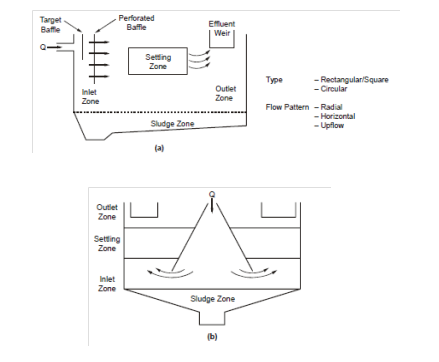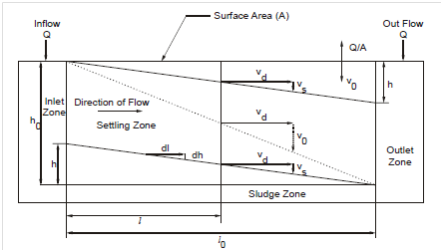Size Determination for Sedimentation Basin
Significant aspects in the determination of size of sedimentation basin are the following:
- Surface loading (m3/m2/h)
- Detention time (h)
- Weir loading rate (m3/m/h)
Sedimentation rate of SS depends at the size of sedimentation particles.

Figure 6: Zones of Sedimentation; (a) Horizontal Flow Clarifier; and (b) Up Flow Clarifier
Inlet Zone
It evenly distributes the flow and suspended solids across the cross-section of the settling zones. It covers approximately 25% of the tank length.
Settling Zone
Where the actual settling of particles takes place.
Sludge Collection Zone of Sludge
Configuration and depth of the sludge zone depends on the method of cleaning and quantity of sludge deposited. Well flocculated solids, 75% settle in the 1/5th of the tank length.
Outlet Zone
Removal of settled water without carrying away any of the flocs. Should be designed to avoid scouring by having either weirs or trough.
Determination of Settling Velocity
Figure 7 shows settling paths of discrete particles in a idealised horizontal flow tank.

Figure 7 : Settling Paths of Discrete Particles in a Horizontal Flow Tank (Idealised)
In Figure 7, vo is the velocity of the particle falling through the full depth h0 of the settling zone in the detention time t0. In Figure 7 above vd is the displacement velocity and vs is the settling velocity.
Therefore, v0 = h0/t0
t0 = V/Q = (l×w×h0)/Q
where, V = Volume of the settling tank, and
w = Width of the channel.
Therefore, surface loading or overflow velocity can be further written as
v0 = Q/l × w = Q/As
where, As = Surface area.
Therefore, removal of particles from the tank is independent of the depth of the tank. All particles with vs ≥ v0 are removed by way of settling in the tank. Thus, the horizontal velocity component or displacement velocity vd should not be very high else the particles will not settle and get washed away.
For design calculations,
vo = 0.8 vs
Particles of vs < v0 can be removed from horizontal flow basins if they are within vertical striking distance of vs/vd × l0 from the sludge zone.
Settling of dilute suspensions which have little or no tendency to flocculate; Type I Sedimentation (Discrete Particle Settling) is assumed. Considering spherical particles, the terminal velocity is provided as
vc = (g (ρs - ρL )/ 18 μ) d 2
where, vc = Terminal velocity,
ρs = Density of the particle,
ρL = Density of the liquid,
g = Acceleration due to gravity,
d = Diameter of particle, and
μ = Dynamic viscosity.
Within the design of sedimentation basins, select a particle wi
th terminal velocity vc and design the basin so that all particles that have settling velocity equal to or greater than vc will be removed.